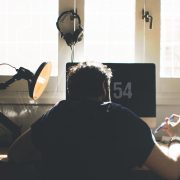How to Tell Good Pain from Bad Pain
Over the last few weeks, we’ve been inundated with people asking for help. And we’re so thankful for everyone who is reaching out!
Since being quarantined at home and off their routines, people are noticing more knee pain and back pain (these are the two biggies) because they are either sitting more — or because they are DOING more.
The folks who have been sitting more have been complaining about more back pain and stiffness, tightness in their hip flexors and knees, and more tension in their necks.
However, the people who have been doing more are noticing increased or NEW aches and pains in their knees, muscles, and joints – and are wondering if this is “normal” or if it’s something to be concerned about.
For some, the aches and pains are quite harmless – and it’s easy enough to stretch out on your own at home. If you’ve been more active lately because you’ve been bored or suddenly have more time, these could be symptoms of “good” pain. It’s not unusual to have more soreness in your muscles and joints with increased activity or exercise.
But for others – these symptoms could be a sign of an underlying problem that was already there – and just now surfacing. And if that’s the case – simple home stretches that you look up online are not going to be enough – and could actually make you worse.
So how do you know?
One way is to look at how your pain behaves. Does it get worse? Or does it get worse, but not until later? Does your pain move around? Or does it come and go? Does it get better and STAY better the more you stretch? Or does the stretch only provide temporary relief — like a bandaid — and your pain just keeps coming back?
Understanding how your pain behaves is how you know whether or not you’re doing the right thing or the wrong thing.
And how your pain behaves is not as simple as “getting better” or “getting worse.”
There is so much grey area when it comes to pain, and it’s where people get really confused.
For example, pain might seem like it’s going away, but then it comes back again. Does that mean you’re better? Or is the problem still there? Sometimes pain will move, and you think it’s a sign of improvement. We see this all the time with back problems. Pain starts in your back and is really painful, but then it moves to your butt, hip, or thigh and is more achy and not as sharp. You think you’re getting better — but most of the time this means your back problem is actually getting worse!
The truth is, you’ve got a 50% chance of getting it right and a 50% chance of getting it wrong. And if you fall on the side of getting it wrong, it can lead to a lot more problems down the line that you won’t be able to fix on your own from home.
The BEST way to figure out if your pain is normal — or if it’s something more — is to talk to an expert.
That’s what we’ve been doing ALL month here. As specialized physical therapists, we have been getting on the phone — or hopping on Zoom — to help you figure out what’s going on in your back, knees, or somewhere else.
It’s totally free to talk to us! We’ll let you know if what you’re experiencing is normal… and if what you’re doing is safe or not.
If you want to get on our schedule — and talk to one of us for free — just fill out this form.
You can talk to us in-person if you’re comfortable leaving your home, or virtually if you’re nervous about leaving. Both methods are equally as effective!
Whatever you do, don’t try to figure out your pain on your own — and don’t just throw pills, ice, or heat at it. This could lead to more problems down the line. Plus, if you let it get bad enough, you may be forced to go to Urgent Care or the ER — two places you DON’T want to be right now.
Instead, get on top of your pain and learn how to treat it properly so that you can be healthy and pain-free for the rest of quarantine!




